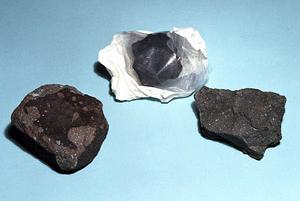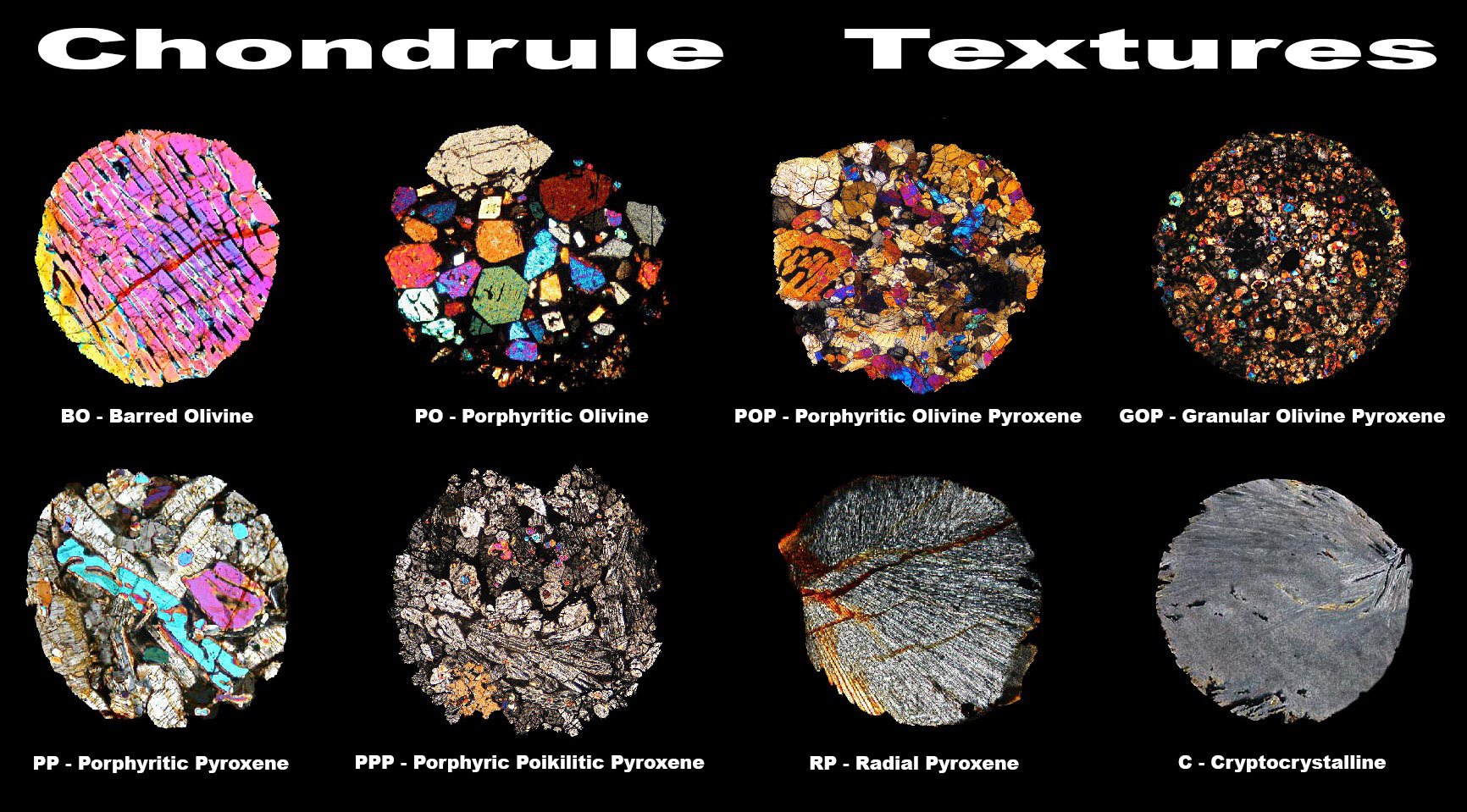|
Moss Meteorite
Moss is a carbonaceous chondrite meteorite that fell over the communities of Rygge and Moss in Østfold county, southeast southern Norway in the morning of midsummer day, July 14, 2006. The last time a type CO3 meteorite fell from the sky was in 1937 with Kainsaz, Russia. There are 6 known falls of a CO3 meteorite. Being of the rare carbonaceous subtype, 'meteorite man' Robert Haag stated to the media that this was the most important meteorite fall since the Canadian Tagish Lake fall in January 2000. History Prelude The summer of 2006 was the meteorite summer in Norway. The summer was very warm and dry. It was perfect weather to protect the valuable droppings that the skies let fall over Norway. It started in the beginning of June when on the 7th a very large meteor explosion was seen and heard over large areas in northernmost Norway. Although no meteorites was found from that event, its size stirred a whole world of meteorite aficionados and a stunned scientific community i ... [...More Info...] [...Related Items...] OR: [Wikipedia] [Google] [Baidu] |
Carbonaceous Chondrite
Carbonaceous chondrites or C chondrites are a class of chondritic meteorites comprising at least 8 known groups and many ungrouped meteorites. They include some of the most primitive known meteorites. The C chondrites represent only a small proportion (4.6%) of meteorite falls. Some famous carbonaceous chondrites are: Allende, Murchison, Orgueil, Ivuna, Murray, Tagish Lake, Sutter's Mill and Winchcombe. General description C chondrites contain a high proportion of carbon (up to 3%), which is in the form of graphite, carbonates and organic compounds, including amino acids. In addition, they contain water and minerals that have been modified by the influence of water. The carbonaceous chondrites were not exposed to higher temperatures, so that they are hardly changed by thermal processes. Some carbonaceous chondrites, such as the Allende meteorite, contain calcium-aluminum-rich inclusions (CAIs). These are compounds that emerged early from the primeval solar nebula, cond ... [...More Info...] [...Related Items...] OR: [Wikipedia] [Google] [Baidu] |
Oslofjord
The Oslofjord (, ; en, Oslo Fjord) is an inlet in the south-east of Norway, stretching from an imaginary line between the and lighthouses and down to in the south to Oslo in the north. It is part of the Skagerrak strait, connecting the North Sea and the Kattegat sea area, which leads to the Baltic Sea. The Oslofjord is not a fjord in the geological sense — in Norwegian the term can refer to a wide range of waterways. The bay is divided into the inner () and outer () Oslofjord, separated by the long by wide Drøbak Sound. The innermost part is known as the Bunnefjorden. Name In the period 1624–1925 the name of the fjord was (or ), since Christiania was the name of the capital in this period. The old Norse name of the fjord was , giving names to the counties of Vestfold ('the district west of Fold') and Østfold ('the district east of Fold') — and also the district Follo. Geography Each of the islands in the innermost part of the fjord has its own identi ... [...More Info...] [...Related Items...] OR: [Wikipedia] [Google] [Baidu] |
Ornans Meteorite
The Ornans meteorite is a carbonaceous chondrite and the type specimen of the CO group (Carbonaceous Ornans group). Its fall was observed in France in 1868. References Meteorites found in France {{Meteorite-stub ... [...More Info...] [...Related Items...] OR: [Wikipedia] [Google] [Baidu] |
Matrix (geology)
The matrix or groundmass of a rock is the finer-grained mass of material in which larger grains, crystals, or clasts are embedded. The matrix of an igneous rock consists of finer-grained, often microscopic, crystals in which larger crystals, called phenocrysts, are embedded. This porphyritic texture is indicative of multi-stage cooling of magma. For example, porphyritic andesite will have large phenocrysts of plagioclase in a fine-grained matrix. Also in South Africa, diamonds are often mined from a matrix of weathered clay-like rock (kimberlite) called "yellow ground". The matrix of sedimentary rocks is finer-grained sedimentary material, such as clay or silt, in which larger grains or clasts are embedded. It is also used to describe the rock material in which a fossil is embedded. Cementation All sediments are at first in an incoherent condition (e.g. sands, clays and gravels, beds of shells), and they may remain in this state for an indefinite period. Millions of years have ... [...More Info...] [...Related Items...] OR: [Wikipedia] [Google] [Baidu] |
Kamacite
Kamacite is an alloy of iron and nickel, which is found on Earth only in meteorites. According to the International Mineralogical Association (IMA) it is considered a proper nickel-rich variety of the mineral native iron. The proportion iron:nickel is between 90%:10% and 95%:5%; small quantities of other elements, such as cobalt or carbon may also be present. The mineral has a metallic luster, is gray and has no clear cleavage although its crystal structure is isometric-hexoctahedral. Its density is about 8 g/cm3 and its hardness is 4 on the Mohs scale. It is also sometimes called balkeneisen. The name was coined in 1861 and is derived from the Greek root ''καμακ-'' "kamak" or ''κάμαξ'' "kamaks", meaning vine-pole. It is a major constituent of iron meteorites (octahedrite and hexahedrite types). In the octahedrites it is found in bands interleaving with taenite forming Widmanstätten patterns. In hexahedrites, fine parallel lines called Neumann lines are often ... [...More Info...] [...Related Items...] OR: [Wikipedia] [Google] [Baidu] |
Troilite
Troilite is a rare iron sulfide mineral with the simple formula of FeS. It is the iron-rich endmember of the pyrrhotite group. Pyrrhotite has the formula Fe(1-x)S (x = 0 to 0.2) which is iron deficient. As troilite lacks the iron deficiency which gives pyrrhotite its characteristic magnetism, troilite is non-magnetic. Troilite can be found as a native mineral on Earth but is more abundant in meteorites, in particular, those originating from the Moon and Mars. It is among the minerals found in samples of the meteorite that struck Russia in Chelyabinsk on February 15th, 2013. Uniform presence of troilite on the Moon and possibly on Mars has been confirmed by the Apollo, Viking and Phobos space probes. The relative intensities of isotopes of sulfur are rather constant in meteorites as compared to the Earth minerals, and therefore troilite from Canyon Diablo meteorite is chosen as the international sulfur isotope ratio standard, the Canyon Diablo Troilite (CDT). Structure Troilit ... [...More Info...] [...Related Items...] OR: [Wikipedia] [Google] [Baidu] |
Olivine
The mineral olivine () is a magnesium iron silicate with the chemical formula . It is a type of nesosilicate or orthosilicate. The primary component of the Earth's upper mantle, it is a common mineral in Earth's subsurface, but weathers quickly on the surface. For this reason, olivine has been proposed as a good candidate for accelerated weathering to sequester carbon dioxide from the Earth's oceans and atmosphere, as part of climate change mitigation. Olivine also has many other historical uses, such as the gemstone peridot (or chrysolite), as well as industrial applications like metalworking processes. The ratio of magnesium to iron varies between the two endmembers of the solid solution series: forsterite (Mg-endmember: ) and fayalite (Fe-endmember: ). Compositions of olivine are commonly expressed as molar percentages of forsterite (Fo) and fayalite (Fa) (''e.g.'', Fo70Fa30). Forsterite's melting temperature is unusually high at atmospheric pressure, almost , while ... [...More Info...] [...Related Items...] OR: [Wikipedia] [Google] [Baidu] |
Chondrules
A chondrule (from Ancient Greek χόνδρος ''chondros'', grain) is a round grain found in a chondrite. Chondrules form as molten or partially molten droplets in space before being accreted to their parent asteroids. Because chondrites represent one of the oldest solid materials within the Solar System and are believed to be the building blocks of the planetary system, it follows that an understanding of the formation of chondrules is important to understand the initial development of the planetary system. Abundance and size Different kinds of the stony, non-metallic meteorites called chondrites contain different fractions of chondrules (see table below). In general, carbonaceous chondrites contain the smallest percentage (by volume) of chondrules, including the CI chondrites which, paradoxically, do not contain ''any'' chondrules despite their designation as chondrites, whereas ordinary and enstatite chondrites contain the most. Because ordinary chondrites represent 80% o ... [...More Info...] [...Related Items...] OR: [Wikipedia] [Google] [Baidu] |
Moss Meteorite, Slice2
Mosses are small, non-vascular flowerless plants in the taxonomic division Bryophyta (, ) ''sensu stricto''. Bryophyta ('' sensu lato'', Schimp. 1879) may also refer to the parent group bryophytes, which comprise liverworts, mosses, and hornworts. Mosses typically form dense green clumps or mats, often in damp or shady locations. The individual plants are usually composed of simple leaves that are generally only one cell thick, attached to a stem that may be branched or unbranched and has only a limited role in conducting water and nutrients. Although some species have conducting tissues, these are generally poorly developed and structurally different from similar tissue found in vascular plants. Mosses do not have seeds and after fertilisation develop sporophytes with unbranched stalks topped with single capsules containing spores. They are typically tall, though some species are much larger. ''Dawsonia'', the tallest moss in the world, can grow to in height. There are ... [...More Info...] [...Related Items...] OR: [Wikipedia] [Google] [Baidu] |
Main Mass
This is a glossary of terms used in meteoritics, the science of meteorites. # * 2 Pallas – an asteroid from the asteroid belt and one of the likely parent bodies of the CR meteorites. * 4 Vesta – second-largest asteroid in the asteroid belt and likely source of the HED meteorites. * 221 Eos – an asteroid from the asteroid belt and one of the likely parent bodies of the CO meteorites. * 289 Nenetta – an asteroid from the asteroid belt and one of the likely parent bodies of the angrites. * 3103 Eger – an asteroid from the asteroid belt and one of the likely parent bodies of the aubrites. * 3819 Robinson – an asteroid from the asteroid belt and one of the likely parent bodies of the angrites. * IAB meteorite, IA meteorite – an iron meteorite group now part of the IAB group/complex. * IAB meteorite – an iron meteorite and primitive achondrite of the IAB group/complex. * IAB meteorite, IB meteorite – an iron meteorite group now part of the IAB group/complex. * IC me ... [...More Info...] [...Related Items...] OR: [Wikipedia] [Google] [Baidu] |
Strewn Field
The term strewn field indicates the area where meteorites from a single fall are dispersed. It is also often used for the area containing tektites produced by large meteorite impact.''Tektites in the geological record: showers of glass from the sky''. Gerald Joseph Home McCall. Geological Society of London, 2001page 10/ref> Formation There are two strewnfield formation mechanisms: # Mid-air fragmentation: when a large meteoroid enters the atmosphere it often fragments into many pieces before touching the ground due to thermal shock. This mid-air explosion disperses material over a large oval-shaped area. The long axis of this oval is along the flight path of the meteoroid. When multiple-explosions occur, the material can be found in several overlapping ovals. # Impact fragmentation: when there is almost no mid-air fragmentation the fragmentation can occur upon impact. In this case the strewnfield shape can be different, usually circular. (e.g. Canyon Diablo at Meteor Crater; Austra ... [...More Info...] [...Related Items...] OR: [Wikipedia] [Google] [Baidu] |






